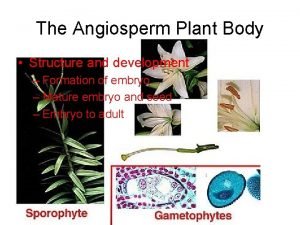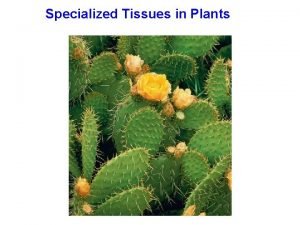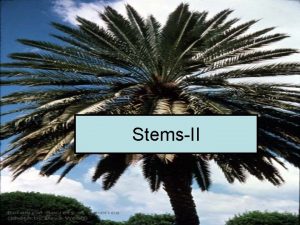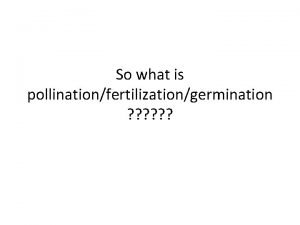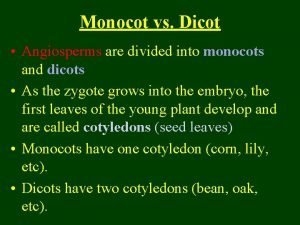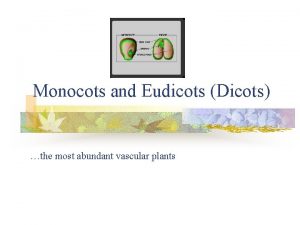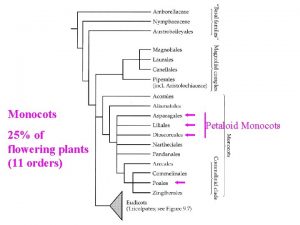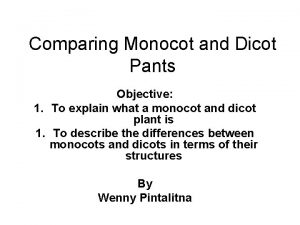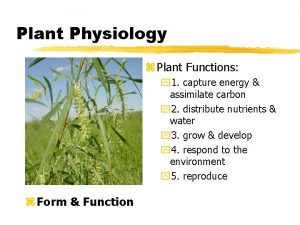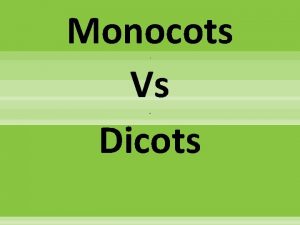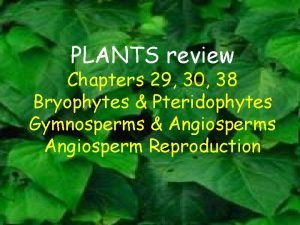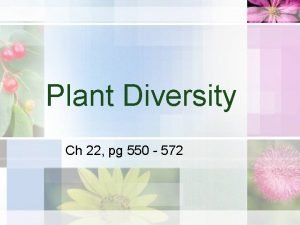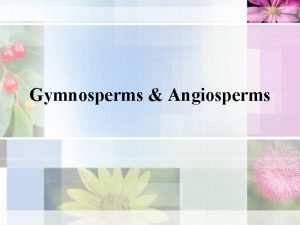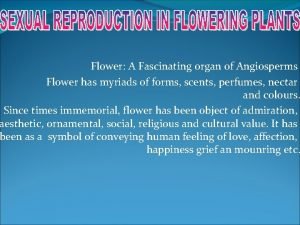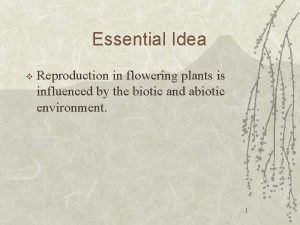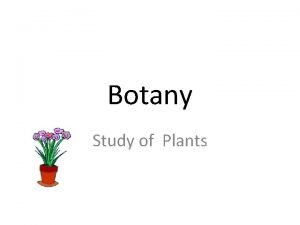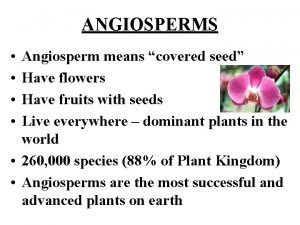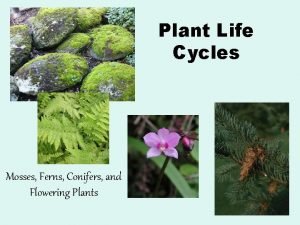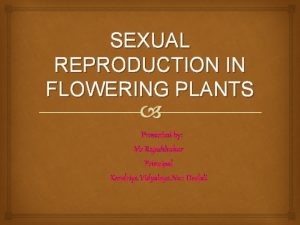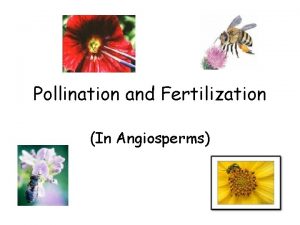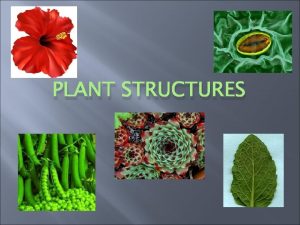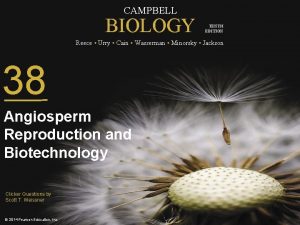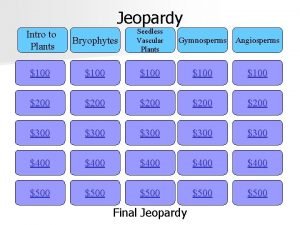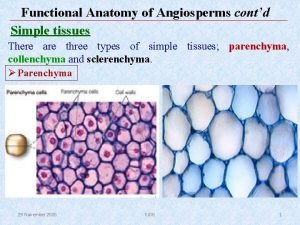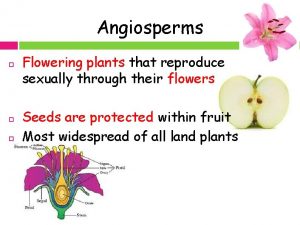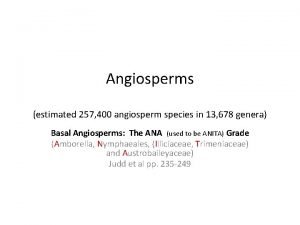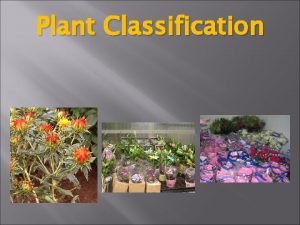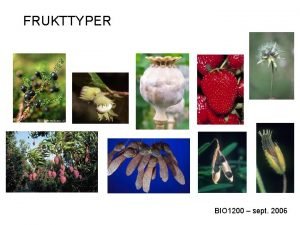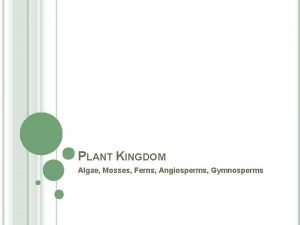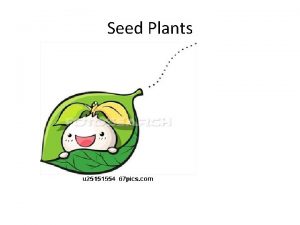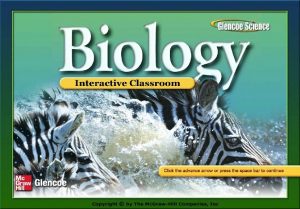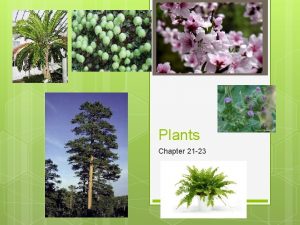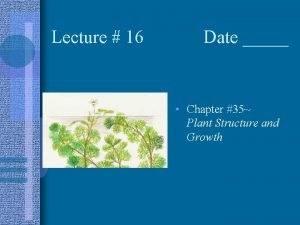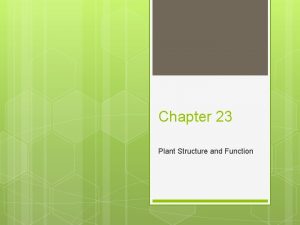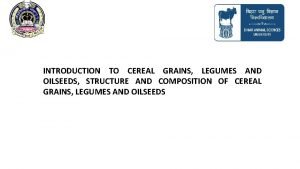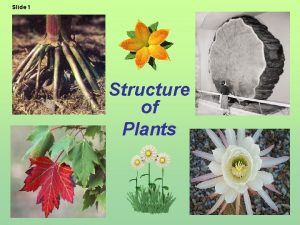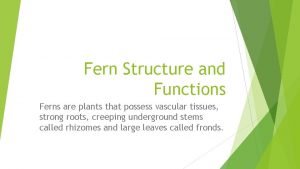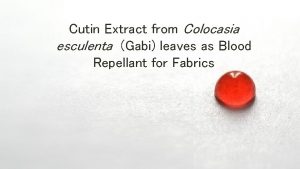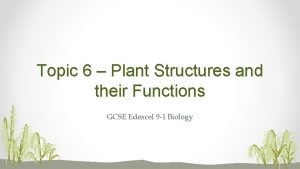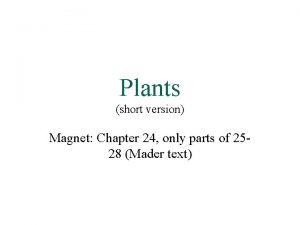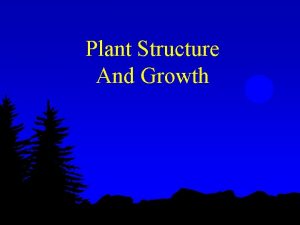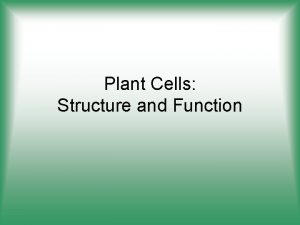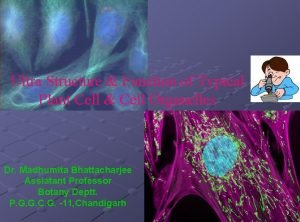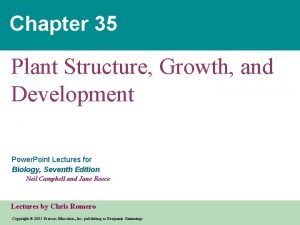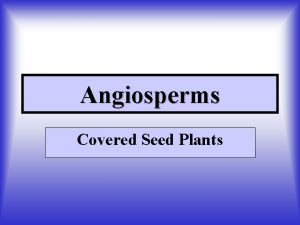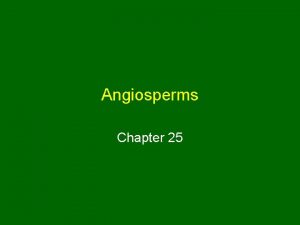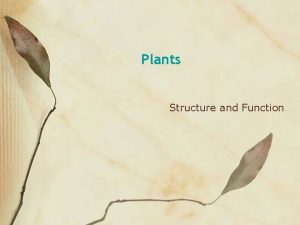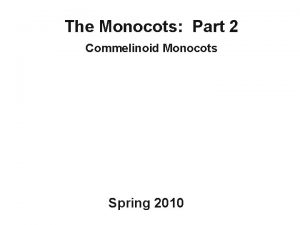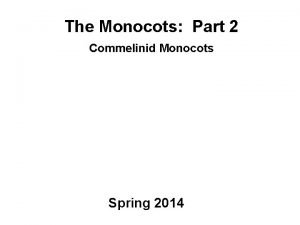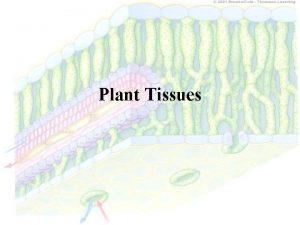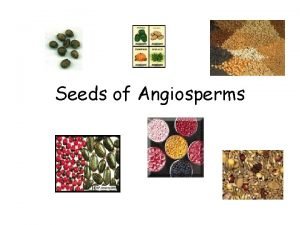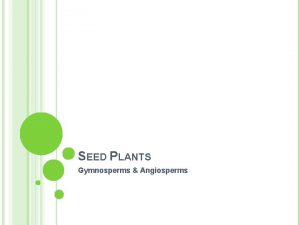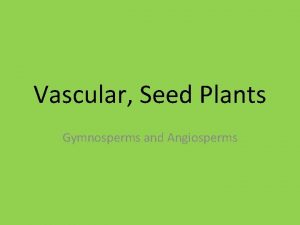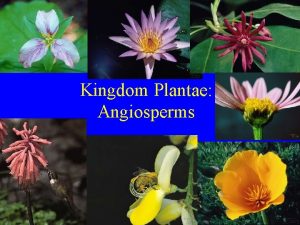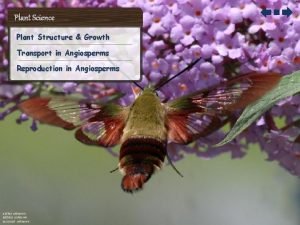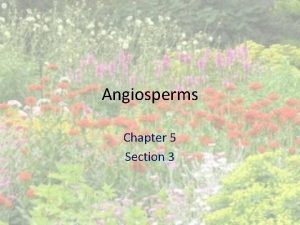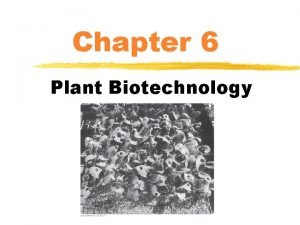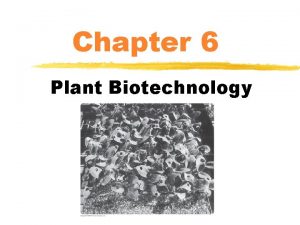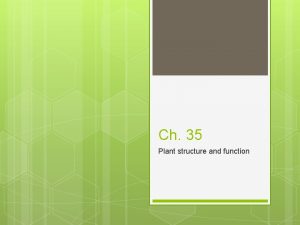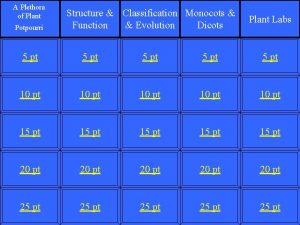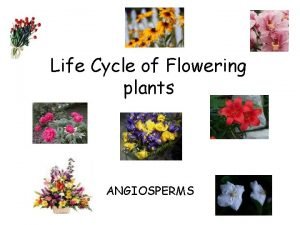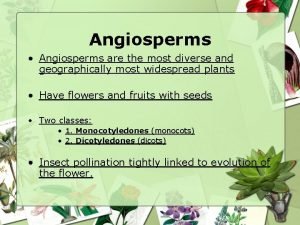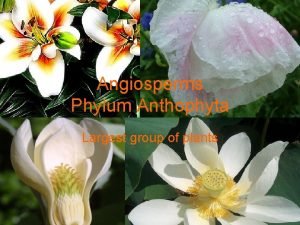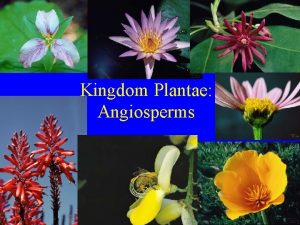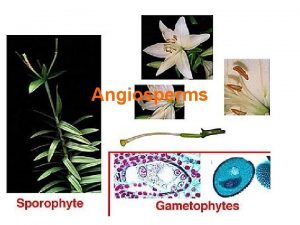Plant Structure Chapter 35 Angiosperms Monocots Seed one











































































- Slides: 75

Plant Structure Chapter 35

Angiosperms Monocots Seed one cotyledon (seed leaf) Leaves parallel veins Roots fibrous Vascular tissue scattered Flower parts 3’s or multiples of 3’s Bulbs, grasses, grains, orchids

Angiosperms Dicots (eudicots) Seed with 2 cotyledon (seed leaf) Leaves with network of veins Taproot Vascular tissue arranged in a ring Flowers in groups of 4 & 5 or multiples Annuals, trees, shrubs, roses, peas


Angiosperms


Organs Root Stem Leaves

Angiosperms


Organs Root system Anchors the plant Absorbs nutrients Water & ions Shoot system Stems & leaves

Roots Tap root One large root with small roots Lateral root Branched roots Adventitious root Root grows from another part of plant Fibrous root Mat of thin roots

Modified roots Prop roots Grow from stem, corn Aerial roots Roots extend in air Plant does not grow into dirt Pneumatophores Plant grows in water Roots above water to get oxygen

Modified roots Parasitic roots Take nourishment from host plants Food storage roots Xylem of roots such as sweet potato Water storage roots Grow in water deprived areas Buttress roots Adds to stability, very large

Root

Shoot system Stem positions leaves Leaves-food production Node: Leave attachment Internode: Area on stem between nodes

Stem (external) Axillary bud: Bud along stem may be a branch Terminal bud: Bud at end where apical meristem

Modified stems Shoots with diverse functions Stolons: Such as “runners” of strawberry plants Grow on the surface Enable a plant to colonize large areas Rhizomes: (iris) Horizontal stems that grow underground.

Modified stems Tubers: (potatoes) Swollen ends of rhizomes Food storage. Bulbs: (onions, tulips) Vertical, underground shoots Swollen bases of leaves-store food.


Modified stems Tendrils: Grapes, ivy give support for climbing Cladphylls: Flattened modified stems Cactus

Leaf (external) Extension of shoot apical meristem Principle site of photosynthesis Expand by cell enlargement Not cell division Growth stops at maturity Blade (flattened) Stalk (petiole) mostly eudicots

Leaf (external) Veins (vascular bundles) Found in leaf Parallel in monocots Network in eudicots Many shapes & arrangements Spiral, paired or whorled

Leaf (external) Simple leaves: One blade with indentations or teeth Compound leaves: Blade divided into leaflets

Modified Leaves Other functions. Tendrils (peas) to cling to supports Spines of cacti for defense Leaves modified for water storage Brightly colored leaves that attract pollinators.

Modified Leaves

Modified leaves

Tissue types 1. Dermal tissue Epidermis (primary growth) One cell layer thick Outer protective layer Cuticle wax cover-water loss Periderm (secondary growth) Replaces epidermis in woody plants

Trichomes Hair like growth Epidermis from shoot “fuzzy” Keep surface cool Minimize evaporation Keep herbivores from eating (sticky surface)

Root hairs Extensions of epidermal cells Occur behind root tips Increase surface area Absorption

Tissue type 2. Vascular tissue Transport Xylem: Water & dissolved minerals Phloem: Carbohydrates (sucrose)

Tissue type 3. Ground tissue Thin-walled parenchyma cells Storage, photosynthesis, support Pith: Internal to vascular tissue Cortex: External to vascular tissue

Tissue type

Plant cells 1. Parenchyma cells Large vacuoles Thin walled 14 sides Most common type of plant cell

Parenchyma Cells Perform most metabolic functions Synthesize & stores various organic products. Fleshy tissue of most fruit.

Parenchyma

Plant cells 2. Collenchyma cells Usually little longer than wide Cell wall thickness varies Support for organs Allows stems to bend & not break

Collenchyma

Plant cells 3. Sclerenchyma cells Supporting elements of the plant Thick secondary walls Much more rigid Cannot elongate Plant regions-stopped lengthening.

Plant cells Lignin: Highly branch polymer Strengthens walls Types sclerenchyma Fibers: Long cells grouped in strands (linen) Sclereids: Branched (pears, seed coats, nutshells)

Sclerenchyma cells

4. Water-conducting cells Xylem (water minerals, inner) Vessel members (elements) Continuous tubes Hollow, dead cylindrical cells end to end Tracheids Dead cells that overlap each other Tapered ends Thick walled Wood is secondary xylem

Xylem

5. Sugar-conducting cells Phloem (outer) Sieve cells Sieve-tube members (elements) Conduct carbohydrates Away from where formed Sieve-tube more advanced

5. Sugar-conducting cells Companion cells: Next to sieve-tube cells Plasmodesmata: Connection between cells

Phloem

Vascular tissue

Growth Meristems: Embryonic tissues Clumps of small cells Dense cytoplasm & large nuclei Similar to stem cells One cell remains meristematic Indeterminate Give rise to other tissues

Meristems Apical meristems Cell division Elongation of roots & stems (tips) Primary growth

Meristems

Apical meristems Primary tissues Tissues resulting from primary growth Primary plant body Made up of primary tissues Young soft shoots, roots Some plants entire plant body

Root 4 regions in developing roots 1. Root cap Protects new cells Moves through soil Perception of gravity Help root to bend down Nitrogen fixing bacteria

Root 2. Region of division Area in center of root tip Apical meristem Cells divide every 12 -36 hours 3. Region of elongation Cells produced are longer than wider 4. Region of maturation (differentiation)

Root Epidermal cells: Root surface have thin cuticle Root hairs Cortex: Parenchyma tissue Between epidermis & vascular tissue

Root Endodermis: Inner boundary of cortex thin layer Casparian strips: Surround the endodermal cells Water cannot pass through the strips

Root

Root


Root

Roots Stele: Tissues interior to endoderm Pericycle: Layer of cells inside endoderm Give rise to lateral or branched roots Pith: Center of root Primary xylem form around the pith Primary phloem form in groups near xylem

Root

Lateral roots

Root

Stem Primordia: Bulges produced by apical meristem Leaves, other shoots, or flowers Intercalary meristems: Add more length at plant internodes Corn


Fig. 35. 18 Copyright © 2002 Pearson Education, Inc. , publishing as Benjamin Cummings

Leaf Stomata: Tiny pores Gap between guard cells Guard cells: Specialized epidermal cells Regulate opening Transpiration: Evaporation of water

Leaf More stomata on lower epidermis Decrease water loss Contain chloroplasts Result from asymmetrical cell division

Leaf Surface covered with epidermis Cuticle Mesophyll: Ground tissue Layer between the epidermis layers Contains veins (vascular bundles)

Leaf Palisade mesophyll: Closest to upper epidermis Tightly packed cells Contains parenchyma with chloroplasts Spongy mesophyll: Loosely arranged Contains air spaces

Leaf

Leaf

Secondary growth Secondary tissues: Lateral meristems Vascular cambium (xylem-wood, phloem) Cork cambium Secondary growth-increases girth

Secondary growth Periderm: Protective layer replaces epidermis Cork plus the cork cambium Lenticels: Raised areas in periderm Areas for gas exchange

Secondary growth

Stem Fig. 35. 22 Copyright © 2002 Pearson Education, Inc. , publishing as Benjamin Cummings
 Semilla de maiz partes
Semilla de maiz partes Plant structure
Plant structure Primary thickening meristem in monocots
Primary thickening meristem in monocots Difference between monocot and dicot
Difference between monocot and dicot Root hair structure
Root hair structure Monocot eudicot
Monocot eudicot Monocots and eudicots
Monocots and eudicots Petaloid monocots
Petaloid monocots Comparing monocots and dicots
Comparing monocots and dicots Monocots vs dicots
Monocots vs dicots Z plant
Z plant Monocots vs dicots
Monocots vs dicots Identify the stamen
Identify the stamen What is the common ancestor of all plants
What is the common ancestor of all plants Types of angiosperm
Types of angiosperm A fascinating organ of angiosperms
A fascinating organ of angiosperms Angiosperms double fertilization
Angiosperms double fertilization Lycophyta
Lycophyta Angiosperm means
Angiosperm means How do angiosperms reproduce
How do angiosperms reproduce Angiosperm life cycle diagram
Angiosperm life cycle diagram Male gametophyte
Male gametophyte Double fertilization in angiosperms
Double fertilization in angiosperms Vessel elements
Vessel elements Double fertilization in angiosperms
Double fertilization in angiosperms Mosses are _____. bryophytes gymnosperms angiosperms
Mosses are _____. bryophytes gymnosperms angiosperms Anatomy of angiosperms
Anatomy of angiosperms Angiosperms
Angiosperms Ana grade angiosperms
Ana grade angiosperms Plants are classified as
Plants are classified as Angiosperms
Angiosperms Ferns and algae kingdom
Ferns and algae kingdom Parts of a bean seedling
Parts of a bean seedling How does iago plant the seed of jealousy in othello?
How does iago plant the seed of jealousy in othello? How does iago plant the seed of jealousy in othello?
How does iago plant the seed of jealousy in othello? Covered seed
Covered seed What part of the plant carries and protects the seed
What part of the plant carries and protects the seed One god one empire one emperor
One god one empire one emperor One one one little puppy run
One one one little puppy run One king one law one faith
One king one law one faith Byzantine definition
Byzantine definition One ford behaviors
One ford behaviors See one do one teach one
See one do one teach one See one, do one, teach one
See one, do one, teach one Night structure
Night structure Studiendekanat uni bonn
Studiendekanat uni bonn One vision one identity one community
One vision one identity one community Asean one vision one identity one community
Asean one vision one identity one community Chapter 22 plant structure and function answer key
Chapter 22 plant structure and function answer key Chapter 21 plant structure and function
Chapter 21 plant structure and function Chapter 35 plant structure growth and development
Chapter 35 plant structure growth and development Vascular ray
Vascular ray Chapter 23 plant structure and function
Chapter 23 plant structure and function Introduction in plant breeding
Introduction in plant breeding Plant breeding for disease resistance
Plant breeding for disease resistance Plant introduction in plant breeding
Plant introduction in plant breeding Tronsmo plant pathology and plant diseases download
Tronsmo plant pathology and plant diseases download Tronsmo plant pathology and plant diseases download
Tronsmo plant pathology and plant diseases download Tronsmo plant pathology and plant diseases download
Tronsmo plant pathology and plant diseases download Apple tree monocot or dicot
Apple tree monocot or dicot Corn seed structure
Corn seed structure Difference between endosperm and cotyledon
Difference between endosperm and cotyledon Barley embryo
Barley embryo Ordinary repairs
Ordinary repairs What produces pollen in a flower
What produces pollen in a flower Plant ground tissue
Plant ground tissue Function of ferns
Function of ferns Animal cell structures
Animal cell structures Animal cell under electron microscope
Animal cell under electron microscope Gabi gabi plant
Gabi gabi plant Obygon
Obygon Moss under microscope labeled
Moss under microscope labeled Plant body structure
Plant body structure Typical plant cell
Typical plant cell Which organelle
Which organelle Xylem und phloem
Xylem und phloem
